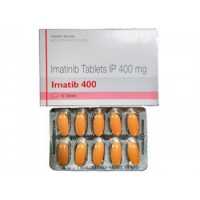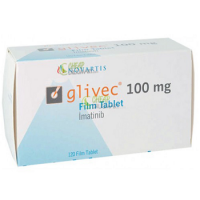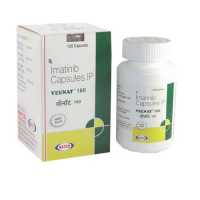Antineoplastic agent, tyrosine kinase inhibitor. Imatinib effectively inhibits the enzyme Bcr-Abl-tyrosinekinase at the cellular level. Imatinib selectively inhibits proliferation and induces apoptosis in cell lines positive for VSG-AKI, as well as immature leukemic cells in chronic myeloid leukemia with positive Philadelphia chromosome (Ph+) and acute lymphoblastic leukemia.
Imatinib : instructions for use Buy Imatinib and price
-
 Imatib 400mg ImatinibIn Stock: много
Imatib 400mg ImatinibIn Stock: много -
 Imatib 100mg ImatinibIn Stock: много
Imatib 100mg ImatinibIn Stock: много -
 Glivec 400mg ImatinibIn Stock: много
Glivec 400mg ImatinibIn Stock: много -
 Glivec 100mg ImatinibIn Stock: много
Glivec 100mg ImatinibIn Stock: много
Imatinib
Pharmacological action
Antineoplastic agent, tyrosine kinase inhibitor. Imatinib effectively inhibits the enzyme Bcr-Abl-tyrosinekinase at the cellular level. Imatinib selectively inhibits proliferation and induces apoptosis in cell lines positive for VSG-AKI, as well as immature leukemic cells in chronic myeloid leukemia with positive Philadelphia chromosome (Ph+) and acute lymphoblastic leukemia. Imatinib selectively inhibits VSG - AN-positive colonies derived from blood cells from patients with chronic myeloid leukemia. In addition, imatinib is a potent inhibitor of the receptor tyrosine kinases for growth factor platelet (PDGF) and stem cell factor (SCF), c-Kit, and inhibits the cell-mediated response, mediated above-mentioned factors. In vitro, imatinib inhibits proliferation and induces apoptosis in stromal tumors of the gastrointestinal tract expressing Kit mutations. Buy Imatinib | price Imatinib India
Pharmacokinetics
Indications for use
- for the treatment of adults and children with newly diagnosed chronic myeloid leukemia with Philadelphia chromosome
- for the treatment of adults and children with Ph+ CML in the phase or blast crisis phase of acceleration, as well as for the treatment of chronic phase after failure of interferon-alpha therapy;
- for the treatment of adult patients with newly diagnosed acute lymphoblastic leukemia with the Philadelphia chromosome (Ph+ALL) in the chemotherapy;
- for the treatment of adult patients with relapsing or refractory Ph+ ALL (as monotherapy);
- myelodysplastic/myeloproliferative diseases (MDS/MPD) adult patients related to the receptor activation and platelet growth factor;
- systemic mastocytosis (CM) with the absence of the D816V c-Kit mutation or in the absence of data on the mutational status of c-Kit in adult patients;
hypereosinophilic syndrome and/or chronic eosinophilic leukemia (HES/CEL) in adults; inoperable, recurrent ;
dermatofibrosarcoma (DFSP) in adults;
inoperable and/or metastatic stromal tumors of the gastrointestinal tract (GIST) in adults;
- adjuvant therapy after resection of GIST in adults.
Contraindications
Hypersensitivity to imatinib mesylate or to any component of the drug.
Children up to age 2 years.
Pregnancy and lactation.
Pregnancy and lactation
During therapy with imatinib women of reproductive age should use effective methods of contraception. In the case of use of imatinib during pregnancy the patient should be warned of the possibility of potential threats to the fetus. Buy Imatinib | price Imatinib instructions
Imatinib and its active metabolite can penetrate into breast milk in lactating women. The women taking imatinib should not breast-feeding.
Method of application and doses
It is recommended to take orally during eating with a full glass of water. Dose 400/600 mg is taken once per day, whereas the drug in a daily dose of 800 mg should use 400 mg 2 times a day, morning and evening.
Treatment can continue, if you do not show signs of exacerbation of the disease or undesirable toxicity.
The recommended dosage of imatinib:
In chronic myeloid leukemia: the recommended dose for the treatment of patients with XMJI in chronic phase is 400 mg daily, for patients with XMJI in the activation phase or blast crisis 600 mg per day.
In chronic myeloid leukemia patients in chronic phase of the disease increase the dosage from 400 mg to 600 mg or for patients in the activation phase or in blast crisis - an increase in dosage from 600 mg to 800 mg (400 mg twice a day) indicated only in the absence of severe side effects and in the absence not related to leukemia, neutropenia or thrombocytopenia. This increase in dose may be necessary in the following circumstances: disease progression (at any stage), the absence of a satisfactory hematological response after 3 months after the start of treatment, no cytogenetic response after 12 months of therapy, the loss of a previously achieved haematological and/or cytogenetic response.
In acute lymphoblastic leukemia Remmanuela dose for the treatment of patients with Ph+ OJIJI is 600 mg per day.
With myelodysplastic/myeloproliferative diseases Remmanuela dose for the treatment of patients with MDS/MPD is 400mg per day.
In systemic mastocytosis Remmanuela dose for the treatment of patients with SM with the absence of the D816V c-Kit mutation is 400 mg per day. For patients with SM associated with eosinophilia, a clonal hematological when pathology is associated with the synthesis of kinase FIPlLl-PDGFRa, the recommended dose is 100 mg per day. Increasing the dose from 100 mg to 400 mg may be considered in the absence of side effects and in the case of insufficient response to therapy.
When hypereosinophilia syndrome and/or chronic eosinophilic leukemia (HES/CEL) Remmanuela dose for the treatment of patients with HES/CEL is 400 mg per day. For patients who have an increased level of tyrosine kinase activity FIPlLl-PDGFRa, the recommended initial dose of 100 mg per day. Increasing the dose from 100 mg to 400 mg may be considered in the absence of side effects and in the case of insufficient response to therapy.
When wybuchowa dermatofibrosarcoma (DFSP) the recommended starting dose of imatinib in adult patients with DPSP is 400 mg/day. If necessary, increase the dose to 800 mg per day.
In the stromal tumors of the gastrointestinal tract (GIST): the recommended dose for the treatment of patients with inoperable and/or metastatic GIST is 400 mg per day. Dose increase from 400 mg to 600 and 800 mg may be considered for patients in whom there are no side reactions, or if response to treatment is not effective enough.
The recommended dose for adjuvant treatment of adult patients after resection of GIST is 400 mg per day. The optimal duration of adjuvant therapy has not been established.
Dosing in special populations: :/a
Children .
Clinical experience on the use of imatinib,teh.delenia-children under 2 years suffering from chronic myeloid leukemia. Experience in use of the drug for the treatment of children for other reasons is not practically available.
Calculation of dosage regimen in children older than 2 years is based on the body surface area (mg/m2). The recommended dose of 260 mg/m2 per day in the chronic phase XMJ1 and 340 mg/m2 per day when XMJ1 in the phase of acceleration, respectively. The total daily dose in children must not exceed the equivalent dose for adults is 400 mg and 600 mg. Treatment should be scheduled once a day or alternative divided into two doses - one morning, another in the evening.
Patients with abnormal liver function
Since imatinib is metabolized mainly in the liver, patients with minor, moderate impaired hepatic function you should assign the minimum recommended dose of 400 mg/day or less, depending on the recommended dose for treatment of the indication. In patients with severe liver dysfunction the recommended dose below 100 mg/day, increase by 100 mg/day to 400 mg/day acceptable in the absence of side effects.
Patients with impaired renal function
A significant highlight of imatinib and its metabolites is via the kidneys does not occur. Patients with impaired renal function or patients on dialysis, drug administered in minimum initial dose of 400 mg. However, when treating this category of patients should be used with caution. In case of intolerance the dose can be reduced. With good tolerability and lack of effectiveness dose can be increased.
Dosing in special cases
Modify dosage in hepatotoxicity and other pathological reactions non-hematologic in nature.
In case of severe non-hematologic adverse reactions (such as severe liver disease or fluid retention) it is necessary to discontinue Imatinib until the disappearance of these phenomena, after which the treatment can be resumed in accordance with the shown reaction.
If you raise the level of bilirubin 3 times above the upper limit of normal or elevated liver transaminases more than 5 times, receiving Imatinib must be suspended until then, until the bilirubin concentration does not decrease to a level that exceeds the upper limit of normal no more than 1.5 times, and the level of hepatic transaminases is not reduced to a level that exceeds the upper limit of normal no more than 2.5 times. After that, treatment with imatinib may be continued at a reduced daily dose. For adults the dose is reduced from 400 to 300 mg or from 600 to 400 mg, or from 800 to 400 mg per day. For children - from 260 to 200 mg/m2 / day or from 340 to 260 mg/ m2 per day. Hematologic adverse reaction
Side effects
In the expanded stage chronic myeloid leukemia or gastrointestinal stromal tumours, patients may have multiple related violations, making assessment of side effects due to a number of symptoms associated with concomitant diseases, their progression and reception of various drugs.
In General, imatinib is well tolerated long-term daily oral administration in patients with XMJI, including in children. Most patients had side effects, usually mild to moderate expressed. The discontinuation of the drug because of side reactions were observed in less than 5% of patients.
The most common adverse events associated with drug intake were mild nausea, vomiting, diarrhea, myalgia, muscle cramps, rash, which were easily controlled. It has often been noted primarily peripheral edema periorbital areas, or edema of the lower extremities. However, they rarely had a pronounced and well to diuretic therapy; in some patients, the swelling took place after lowering the dose of imatinib.
Various adverse events such as pleural effusion, ascites, pulmonary edema and rapid weight gain peripheral edema with or without them can be generally classified as fluid retention.
Adverse events are listed below by organ and systems, indicating the frequency of their occurrence.
The determination of the frequency, very common (1/10), often (1/100 to 1/10), uncommon (1/1000 to 1/100), rare (1/10000 to 1/1000), very rare (1/10000).
Infectious and parasitic diseases: rarely, herpes simplex, herpes zoster, nasopharyngitis, pneumonia, sinusitis, cellulitis, upper respiratory tract infection, influenza, infections of the urinary tract, gastroenteritis, sepsis; rarely fungal infections.
Violations by the blood and lymphatic system: very often - neutropenia, thrombocytopenia, anemia; often - pancytopenia, febrile neutropenia; rare - thrombocythemia, lymphopenia, depression of bone marrow function, eosinophilia, lymphadenopathy; rare - hemolytic anemia.
Violations of metabolism and nutrition: often - anorexia; rarely, hypokalaemia, increased appetite, hypophosphatemia, decreased appetite, dehydration, gout, hyperuricemia, hyperglycemia, hypercalcemia, hyponatremia; rarely hyperkalemia, hypomagnesemia.
Mental disorders: often - insomnia, rarely - depression, decreased libido, anxiety; rare - confusion.
Disorders of the nervous system: very often - headache, often - dizziness, paresthesia, impaired taste sensation, hypesthesia; rare - headache, drowsiness, loss of consciousness, peripheral neuropathy, memory impairment, sciatica, syndrome "restless" legs, tremor, bleeding in the brain; rarely increased intracranial pressure, convulsions, optic neuritis.
Violations of the organ of vision: often - swelling of the eyelids, increased tearing, conjunctival hemorrhage, conjunctivitis, dry eyes, blurred vision; rarely, irritation in eyes, eye pain, orbital edema, hemorrhages in sclera, hemorrhage into the retina, blepharitis, macular edema, rarely - cataracts, glaucoma, papilloedema.
Violations of the organ of hearing and labyrinth disorders: infrequent - vertigo, tinnitus, hearing loss.
Disorders of the heart: rarely palpitation, tachycardia, congestive heart failure, pulmonary edema; rare - arrhythmia, atrial fibrillation, cardiac arrest, myocardial infarction, angina, pericardial effusion.
Violations by vessels: often - feeling of blood flow, hemorrhage; rarely, hypertension, hematoma, sensation of cold in the extremities, hypotension, Raynaud's phenomenon.
Violations of the respiratory system, chest and mediastinum: common - dyspnoea, epistaxis, cough; rarely, pleural effusion, pharyngo - laryngeal pain pharyngitis; rarely chest pain, pulmonary fibrosis, pulmonary hypertension, pulmonary hemorrhage.
Violations by the gastrointestinal tract: very often - nausea, diarrhea, vomiting, dyspepsia, abdominal pain; often, flatulence, bloating, gastroesophageal reflux, constipation, dry mouth, gastritis; rare - stomatitis, mouth ulcers, bleeding from the gastrointestinal tract, eructation, melena, esophagitis, ascites, gastric ulcer, vomiting blood, cheilitis, dysphagia, pancreatitis; rare - colitis, ileus, inflammatory processes in the intestine.
Violations of the liver and biliary system: often - increased levels of liver enzymes; rarely, hyperbilirubinemia, hepatitis, jaundice, rarely hepatic failure, hepatic necrosis.
Violations of the skin and subcutaneous tissue: often - periorbital oedema, dermatitis/eczema/rash; often - itching, swelling of the face, dry skin, erythema, alopecia, night sweats, photosensitivity reaction; rarely, pustular rash, sweating, urticaria, ecchymosis, increased tendency to hemorrhage, (hypotrichs, hypopigmentation of skin, exfoliative dermatitis, brittle Naggai^ folliot, petechiae, psoriasis, purpura, skin hyperpigmentation, bullous eruptions; rarely, acute febrile neutrophilic dermatosis syndrome (Entourage), color changing nails, angioneurotic edema, vesicular rash, erythema multiforme, leucocytoclastic vasculitis, Stevens-Johnson syndrome, acute generalized pustular eruption asantemanso.
Violations by musculoskeletal and connective tissue: often - muscle spasms and cramps, pain in muscles and bones, including myalgia, arthralgia, bone pain, often swelling of the joints; rarely, stiffness in joints and muscles; rare - muscle weakness, arthritis.
Violations of the kidney and urinary tract: rarely - pain in region of kidney, hematuria, acute renal failure, increased frequency of urination.
Violations of the genital organs and mammary glands: rarely - gynecomastia, erectile dysfunction, menorrhagia, menstrual disorders, sexual dysfunction, pain in the nipples, breast enlargement, swelling of the scrotum.
Other: very often - fluid retention and swelling, fatigue, weight gain; common - weakness, fever, anasarca, chills, tremors, weight loss, and rarely chest pain, malaise, increased creatinine in the blood, increased blood creatine phosphokinase, increased lactate dehydrogenase in the blood, increase of alkaline phosphatase in the blood; rarely - increased amylase in the blood.
Overdose
Symptoms: may increase side effects.
Treatment: you must install the monitoring of the patient and assign appropriate maintenance therapy.
Interaction with other drugs
Increasing the concentration of imatinib in plasma is possible with simultaneous use with drugs that inhibit the CYP3A4 isoenzyme of cytochrome P450 (eg, ketoconazole, Itraconazole, erythromycin, clarithromycin). On the contrary, the simultaneous use of drugs that are CYP3A4 inducers (e.g., dexamethasone, phenytoin, carbamazepine, rifampicin, phenobarbital or St. John's wort preparations (Hypericum perforatum)) may lead to increased imatinib metabolism and decrease its plasma concentration. For patients who are on rifampicin or other inducers of CYP3A4 should be considered alternative therapeutic agents with less ability to induce the enzymes.
Imatinib increases Withmax and AUC of simvastatin 2-and 3.5 fold, respectively by inhibiting CYP3A4 by imatinib. Use caution with the concomitant use of imatinib and drugs that are substrates of CYP3A4 and have a narrow range of therapeutic concentration (e.g., cyclosporine or pimozide). Imatinib may increase plasma concentration of other drugs, metaboliziruemah CYP3A4 (e.g., triazolobenzodiazepine, digidropiridinovmi calcium channel blockers, inhibitors of HMG-COA reductase).
In vitro imatinib inhibits the activity of CYP2D6 isoenzyme of cytochrome P450 in those concentrations that affect CYP3A4 activity. Imatinib at a dose of 400 mg 2 times a day and shows weak inhibitory effect on СУР2Б6-mediated metoprolol metabolism, with an increase in Cmax and AUC of metoprolol by approximately 23%. Simultaneous administration of imatinib and CYP2D6 substrates such as metoprolol, does not lead to the emergence of risk factors of interaction between drugs, so dose adjustment is not required. Buy Imatinib | price Imatinib India instructions
It is necessary to consider the possibility of strengthening effects of drugs that are substrates of the CYP2D6 isoenzyme, in their joint application with imatinib. Imatinib inhibits O-glucuronidation of paracetamol/ acetaminophen.
Imatinib inhibits the activity of CYP2C9 and CYP2C19, so with the combined use of warfarin observed prolongation of prothrombin time. While the use of coumarin derivatives needed short-term monitoring of prothrombin time in the beginning and end of therapy with imatinib, and when changing the dosing regimen of imatinib. Alternatively, warfarin is recommended to use low molecular weight derivatives of heparin.
In all cases, when there is a need to take imatinib together with any additional drugs, you need to consult with your doctor.
Application features
Treatment with imatinib should be done only under the supervision of a doctor who has experience with anticancer drugs.
Caution must be exercised in the appointment of imatinib in patients with impaired liver function because it may increase the severity of his actions.
When handling drug should avoid getting it on your skin and eyes and inhalation of powder medication.
Due to the fact that the application of imatinib possible severe fluid retention (pleural effusion, peripheral edema, pulmonary edema, ascites), in patients it is recommended regularly to determine the body weight. In the case of rapid unexpected weight-gain, should undertake the examination of the patient and, if necessary, assign the appropriate symptomatic therapy.
Laboratory tests. During therapy it is a systematic complete clinical analysis peripheral blood. In applying the drug in patients with chronic myeloid leukemia observed neutropenia and thrombocytopenia, however, their appearance depends on the phase of the disease. When blast crisis in the phase of acceleration of these adverse events are more common than in the chronic phase of the disease. If you experience these adverse events it is recommended to temporarily stop the drug or reduce the dose.
During therapy showing regular monitoring of liver function (Transaminase, bilirubin, alkaline phosphatase). In the event of deviations"'etih“лабораторнБ1х-т10казателей from the norm, it is recommended to reduce the dose of imatinib or temporarily cancel it.
Patients with heart disease or renal failure
Should closely monitor patients with heart disease, the risk factors for heart failure, or kidney failure in history; patients with signs or symptoms of heart failure need to examine and prescribe treatment. Elderly patients and patients with heart disease must be defined by the indicators ejection fraction of the left ventricle (LVEF) prior to initiation of treatment with imatinib.
In patients with eosinophilia syndrome (HES) and cardiac dysfunction individual cases of cardiogenic shock/disturbances of left ventricular function were associated with starting treatment with imatinib. It was reported that the appointment of systemic steroids, use of systems to maintain circulation and temporary discontinuation of imatinib such States wore reversible.
Myelodysplastic/myeloproliferative diseases and systemic mastocytosis may be associated with high levels of eosinophils. Therefore, in patients with HES/CEL, and in patients with MDS/MPD or SM associated with high levels of eosinophils, should monitor the ECG and to determine the level of troponin in the serum. If marked pathological changes, during the initial phase of treatment should consider prophylactic use of systemic steroids (1-2 mg/kg) for 1-2 weeks as concomitant with imatinib therapy.
Gastrointestinal bleeding
In patients with tumors of the gastrointestinal tract can occur gastrointestinal bleeding, therefore before starting therapy, patients should monitor the possible development of symptoms of gastro-intestinal tract.
The tumor lysis syndrome
In patients treated with imatinib, there have been cases of tumor lysis syndrome (SLO). In view of the possible development of SLO before the start of therapy with imatinib should be the correction of clinically significant dehydration and to control the high levels of uric acid.
Hypothyroidism
Reported clinical cases of hypothyroidism in patients receiving replacement therapy with levothyroxine after tireoidektomii when conducting the combination therapy with Glivec. Such patients should regularly monitor the level of thyroid stimulating hormone.
Children and adolescents
There are reports of growth retardation observed among children and pre-adolescents receiving imatinib. Long-term effects long-term use of the drug on growth in children is not established. Therefore, children who are receiving therapy with imatinib, it is recommended to carefully control growth.
Sufficient experience with the drug in children with CML under 2 years are not available.
Imatinib and its metabolites are excreted through the kidneys in small quantities. As we know, creatinine clearance (Clcr) decreases with age, and age does not have large impact on the kinetics of the drug. In patients with impaired renal function, the level of imatinib in plasma is slightly higher than in patients with normal renal function (possibly in connection with a high level of acid alpha-glycoprotein, which is machineswomen protein in these patients). In patients with mild (creatinine clearance 40-59 ml/min) and severe (creatinine clearance <20 ml/min) renal failure of the relationship between exposure of imatinib and the degree of renal dysfunction defined by creatinine clearance level. However, when poor tolerability of the initial dose of the drug can be reduced. Buy Imatinib | price Imatinib instructions
Use in geriatrics. Special recommendations on dosing for patients older than 65 years are not required.
Effects on ability to drive vehicles and potentially dangerous machinery. Some side effects of the drug such as dizziness and blurred vision, may adversely affect the ability to drive vehicles and perform potentially hazardous activities, require high concentration and psychomotor speed reactions. Therefore, we recommend caution while driving motor transport or operating other mechanisms.


